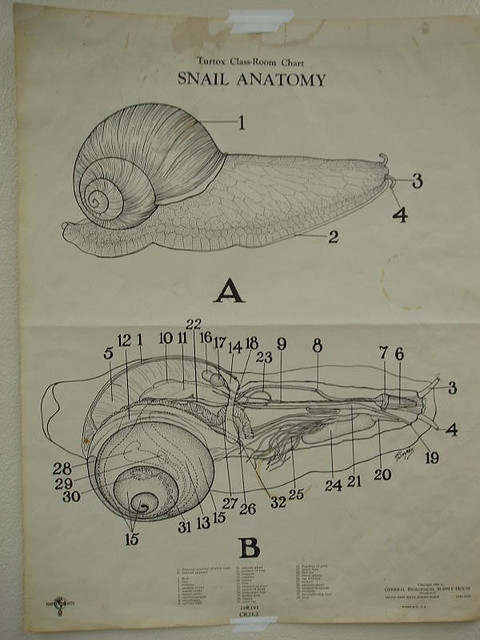Molluscan Meat
In catching snails which one will cook oneself, one experiences the joy of a hunter who stalks his prey, anticipatory stew, and that of the fisherman casting his line, with matelote* before his mind’s eye. — Alain Laubreaux, The Happy Glutton
Soft, extensile and capable of compassing their way to any crop of cabbage, that local common garden snail is a European brown snail. In Dutch it’s called segrijnslak; in Latin, Helix aspersa. Whichever name, it’s considered by gardeners as a notorious nocturnal creature who over exploits the succulent greens. Snails are hermaphrodite, at once male and female, and purportedly very promiscuous.
In 2007 we started collecting unwanted snails from allotment gardens around Amsterdam. Snail scouring areas on the hit list so far include the Volkstuinen Blijkmeer, Nut en Genoegen and Sloterdijkermeer. July-August are the months of abundance, and they multiply even more when it rains during warm spells with even enough to start up a small snail farm at home, and eventually, when the snails are plump enough, to host a hermaphrodite dinner.
Snail farm or not, it is necessary to purify the snails to render them safe before eating. Both ancient and contemporary gastrophagers have purified and fattened snails by feeding them non-toxic and flavoursome herbs (borage [a snail favourite!], basil, dragon and marjoram) as well as minute amounts of beer or wine since snails, like humans, are attracted to yeast, especially fermented alcoholic beverages. Be careful when giving them wine, more than a droplet could kill them.
No one ever quite got used to the habit of eating land snails in Britain or the Netherlands. In early 20th century England they were euphemistically sold as ‘wall fish’ (cited in Snail, Peter Williams). In the Netherlands there is no distinction made with the word ’slakken’ which means both snails or slugs. When one talks about ’slakken’ one needs to get to a point of clarification in the conversation if one actually means slugs (’naaktslak’, lit. naked snails) or snails (’huisjesslak’, lit. house snail). While we considered cooking some slugs, one Amsterdam malacologist said that their slime is 100 times more prominent than the snail and difficult to remove after they are dead, and besides, slugs are anything-eaters, not unlikely that slugs carry an abundance of pathogenic microbes and parasites from eating cadavers and the like.
Several online sources describe the edibility or farming of the common garden snail. Here are some of our favourites:
Fidgety Fingers Which Garden Snail Is Edible?
BBC Great Snail Hunt, citizen-science guide to identifying snails in your garden
On Heliculture (snail farming): French website on How to rear snails and cook them
*a dish of fish in a sauce of wine and onions (from the French à la matelote, lit, ‘mariner-style’
